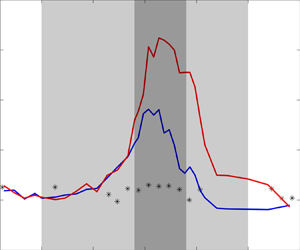Article contents
Enhanced extreme wave statistics of irregular waves due to accelerating following current over a submerged bar
Published online by Cambridge University Press: 09 January 2023
Abstract

We present experimental results of irregular long-crested waves propagating over a submerged trapezoidal bar with the presence of a background current in a wave flume. We investigate the non-equilibrium phenomenon (NEP) induced by significant changes of water depth and mean horizontal flow velocity as wave trains pass over the bar. Using skewness and kurtosis as proxies, we show evidence that an accelerating following current could increase the sea-state non-Gaussianity and enhance both the magnitude and spatial extent of the NEP. We also find that below a ‘saturation relative water depth’  $k_p h_2 \approx 0.5$ (
$k_p h_2 \approx 0.5$ ( $k_p$ being the peak wavenumber in the shallow area of depth
$k_p$ being the peak wavenumber in the shallow area of depth  $h_2$), although the NEP manifests, the decrease of the relative water depth does not further enhance the maximum skewness and kurtosis over the bar crest. This work highlights the nonlinear physics according to which a following current could provoke higher freak wave risk in coastal areas where modulation instability plays an insignificant role.
$h_2$), although the NEP manifests, the decrease of the relative water depth does not further enhance the maximum skewness and kurtosis over the bar crest. This work highlights the nonlinear physics according to which a following current could provoke higher freak wave risk in coastal areas where modulation instability plays an insignificant role.
- Type
- JFM Papers
- Information
- Copyright
- © The Author(s), 2023. Published by Cambridge University Press
References
REFERENCES
- 7
- Cited by





